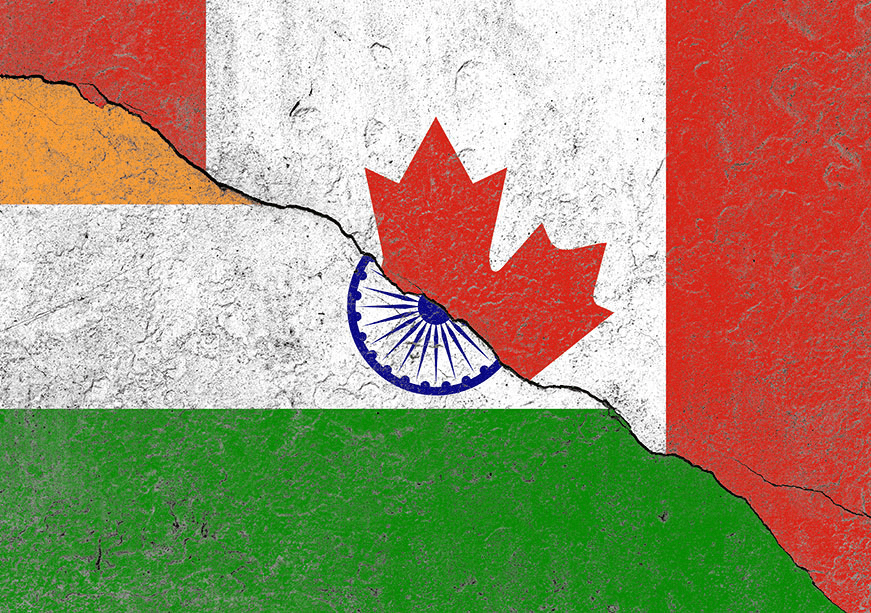Current Affairs 2024 - Navigating India-Canada Relations: From Historical Bonds to Contemporary Strains
Feb, 2025
•3 min read
India and Canada share a rich history of diplomatic relations rooted in mutual respect and shared interests. However, recent tensions, especially in light of the 2023 diplomatic crisis, have cast a shadow over what was once a steadily growing relationship. This blog delves into the factors that have shaped India-Canada relations from their early days to the challenges of today, exploring both the historical context and contemporary issues affecting this bilateral partnership.
Early Diplomatic Ties: The Foundations of Friendship (1947–1970s)
- Post-Independence Relations: Canada was one of the first nations to recognize India's independence and extend economic and technical support, primarily through the Colombo Plan.
- Commonwealth and UN Membership: Both countries were members of the Commonwealth and the UN, forming a basis for shared multilateral engagements.
- Prime Ministerial Visits: Jawaharlal Nehru and Indira Gandhi’s visits helped deepen diplomatic and cultural connections.
Nuclear Fallout: A Major Setback in the 1970s
- Nuclear Test: India's 1974 nuclear test (Smiling Buddha) caused a rift as Canada, which provided India with nuclear technology for civilian use, felt betrayed.
- End of Nuclear Cooperation: Canada imposed sanctions and froze nuclear cooperation, creating a significant diplomatic setback.
Rebuilding Relations in the Post-Cold War Era (1990s–2000s)
- Economic Liberalization: India’s economic reforms in the 1990s attracted Canadian interest in trade, investment, and cooperation in agriculture, technology, and education.
- 2008 Indo-U.S. Civil Nuclear Agreement: This landmark deal helped India resume nuclear ties with other nations, including Canada, leading to a 2010 uranium supply agreement.

Tensions Over the Sikh Diaspora and Khalistan Movement
- Sikh Diaspora: Canada has a significant Sikh population, and some factions have supported the Khalistan movement, which aims to create a separate Sikh state.
- 1985 Air India Bombing: Orchestrated by Khalistani extremists based in Canada, this tragic incident remains a critical aspect of the diaspora's influence on bilateral relations.
- Persistent Tensions: The Indian government has periodically raised concerns about Canada’s perceived tolerance of pro-Khalistani groups.
Economic Cooperation Amidst Political Frictions (2010s–Present)
- Trade and Investment: Despite political issues, Canada is an important trading partner, with major investments in sectors like renewable energy and infrastructure.
- 2018 Trudeau Visit: Prime Minister Trudeau’s visit to India was overshadowed by Khalistani controversies, underscoring political tensions amidst economic ties.
The Diplomatic Crisis of 2023: A New Low in Relations
- Assassination Allegations: In 2023, Canadian Prime Minister Trudeau alleged Indian involvement in the assassination of Khalistani activist Hardeep Singh Nijjar in Canada.and India temporarily suspended visa services for Canadians. The incident drew international attention, and allies called for a
- Diplomatic Fallout: Both nations expelled diplomats, with India suspending visa services for Canadians temporarily. The incident drew international attention, with allies calling for a and India temporarily suspended visa services for Canadians. The incident drew international attention, and allies called diplomatic resolution.
- Impact on Trade and Student Mobility: With Canada tightening visa restrictions, there are significant impacts on trade relations, the Indian diaspora, and students studying in Canada.
Impacts of Strained Relations:
- Diaspora Influence: India has a sizable diaspora in Canada, and disruptions in consular services affect students, professionals, and families, impacting people-to-people ties.
- Trade and Economy: With bilateral trade valued at $19 billion, economic insulation has been a focus, though current tensions may impact long-term investments.
- Student Exchange: Visa restrictions could hamper the aspirations of thousands of Indian students, signaling further strain on educational cooperation.
Way Forward: Steps to Rebuild Diplomatic Ties
- Diplomatic Dialogue: Establishing a channel for open communication is crucial. Diplomatic dialogue, potentially through multilateral forums like the G20, could foster mutual understanding and address key issues, from separatism to foreign interference concerns.
- Economic Insulation: Maintaining economic collaboration separately from political issues would serve both nations. Canadian investments in India’s infrastructure, renewable energy, and education sectors should be safeguarded to keep mutual economic benefits intact.
- Multilateral Engagement: Both India and Canada are active in organizations like the United Nations and G20. Collaborative efforts on issues such as climate change, trade, and sustainable development could help restore trust.
- Addressing Domestic Pressures: Canada can engage its Sikh diaspora while ensuring that no segment of the population promotes activities contrary to India’s territorial integrity. India, in turn, can reinforce its commitment to democratic values and multi-religious inclusivity to maintain trust among global partners.
Conclusion: Toward a Balanced Partnership
India and Canada have navigated a relationship filled with highs and lows, from Cold War collaborations to the contemporary challenges posed by diaspora-related tensions. Moving forward, diplomatic maturity, mutual respect, and strategic collaboration on shared issues—like climate action, trade, and technological growth—can pave the way for a stronger, more resilient relationship.
As the two nations look toward a challenging but hopeful future, diplomatic efforts and mutual understanding will be critical to overcoming the roadblocks in India-Canada relations and fostering a partnership based on shared global goals.

![Aravali Range in News [UPSC 2025]](/_next/image?url=https%3A%2F%2Fblog-media.superkalam.com%2Faravali_hills_f4a51f37bf.jpeg&w=3840&q=75)
![MGNREGA Vs VB-G RAM G [UPSC 2025]](/_next/image?url=https%3A%2F%2Fblog-media.superkalam.com%2FMGNREGA_vs_GRAMG_ea46241736.jpeg&w=3840&q=75)